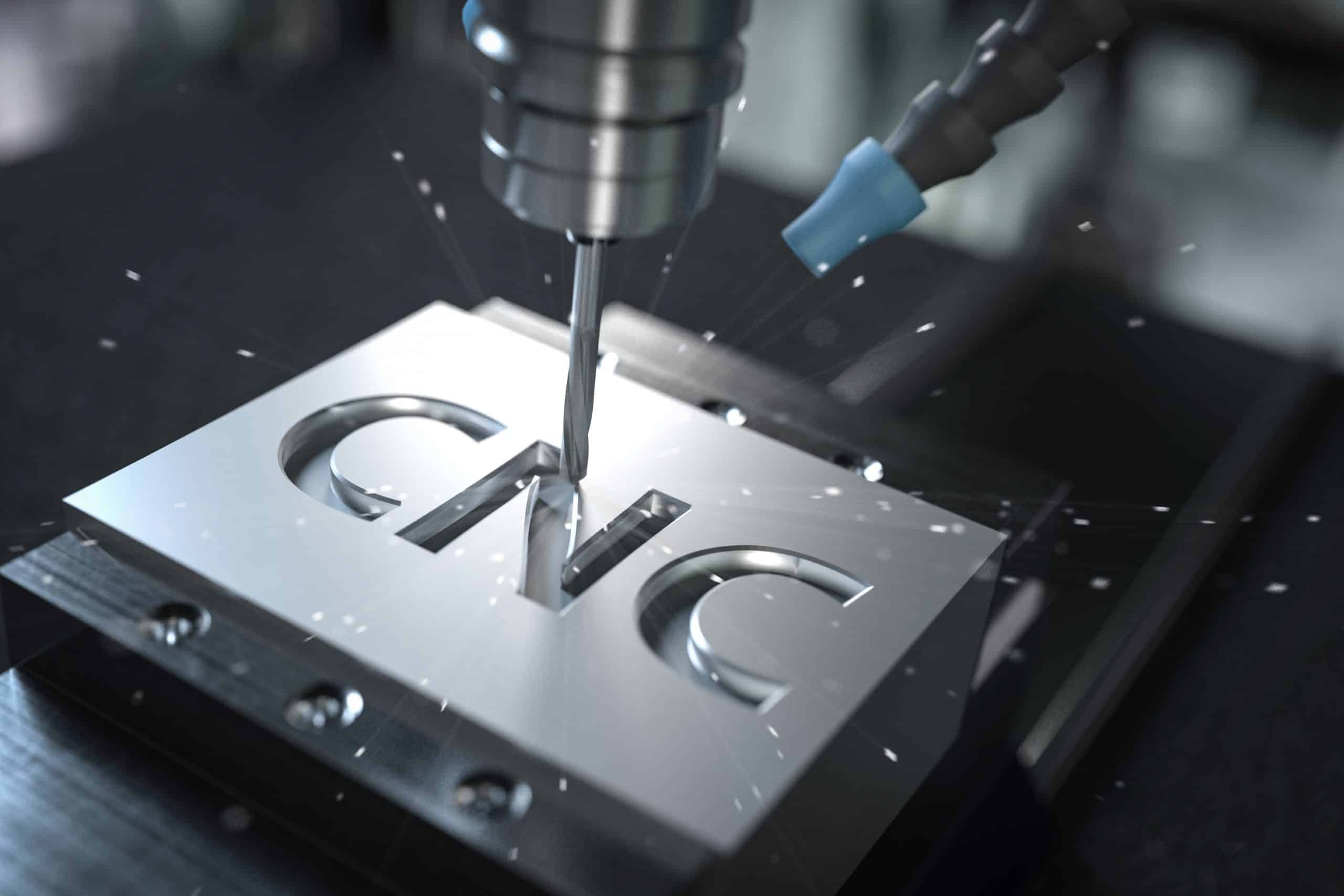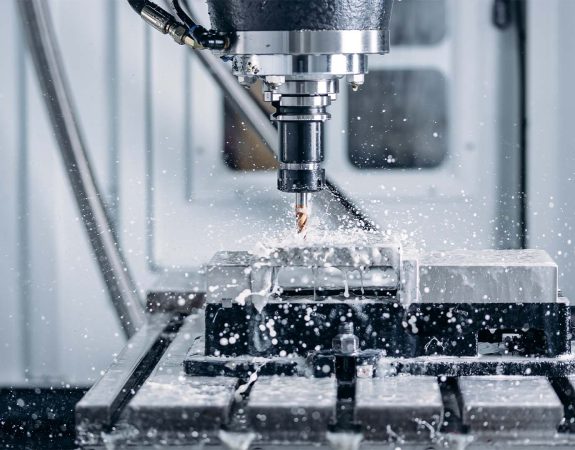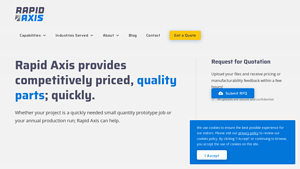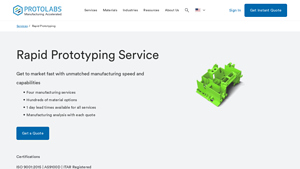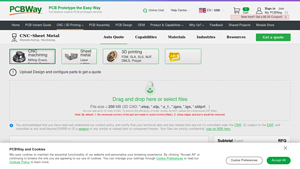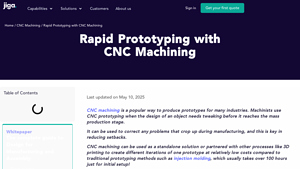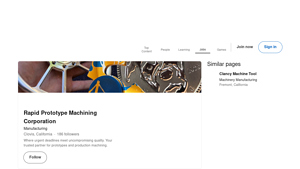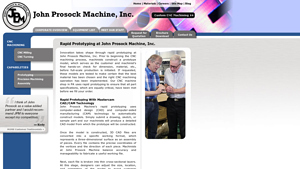Rapid Prototype Machining Guide: Type, Cost, Top List…
Introduction: Navigating the Global Market for rapid prototype machining
In the fast-paced world of product development, sourcing rapid prototype machining services can be a daunting challenge for international B2B buyers. Companies across Africa, South America, the Middle East, and Europe are increasingly recognizing the importance of rapid prototyping in accelerating their innovation cycles while minimizing costs. This guide delves into the multifaceted landscape of rapid prototype machining, offering valuable insights into various processes such as 3D printing, CNC machining, and injection molding.
We will explore the diverse applications of rapid prototyping, from aerospace to consumer electronics, and provide actionable strategies for vetting suppliers effectively. Understanding the nuances of each manufacturing method will empower buyers to make informed decisions that align with their specific project requirements. Additionally, we will address critical factors such as pricing structures, lead times, and material selection, equipping businesses with the knowledge needed to navigate this complex market confidently.
By leveraging this comprehensive guide, international B2B buyers can streamline their procurement processes, reduce risks associated with product development, and ultimately enhance their competitive edge in the global marketplace. Whether you’re a seasoned professional or new to the field, this resource is designed to support your journey towards successful sourcing and implementation of rapid prototype machining solutions.
Understanding rapid prototype machining Types and Variations
| Type Name | Key Distinguishing Features | Primary B2B Applications | Brief Pros & Cons for Buyers |
|---|---|---|---|
| 3D Printing | Fast, affordable, and versatile; suitable for complex geometries. | Prototyping in aerospace, automotive, and consumer products. | Pros: Quick turnaround, low cost; Cons: Limited material strength for some applications. |
| CNC Machining | High precision and ability to use a variety of materials. | Manufacturing parts for medical devices, electronics, and automotive. | Pros: Excellent surface finish, high accuracy; Cons: Longer lead times compared to 3D printing. |
| Sheet Metal Fabrication | Ideal for flat parts; quick turnaround for metal prototypes. | Used in automotive, electronics, and industrial applications. | Pros: Cost-effective for bulk orders; Cons: May require more setup time than 3D printing. |
| Injection Molding | Suitable for high-volume production; precise dimensions. | Consumer products, automotive, and medical devices. | Pros: High consistency and quality in large runs; Cons: Higher initial setup costs. |
| Urethane Casting | Good for low-volume production with detailed finishes. | Prototyping in consumer products and industrial components. | Pros: Smooth finishes and good detail; Cons: Limited to softer materials. |
What Are the Key Characteristics of 3D Printing in Rapid Prototyping?
3D printing is the most prevalent method in rapid prototyping due to its speed and cost-effectiveness. It allows for the production of complex geometries that are difficult to achieve with traditional manufacturing methods. This technique is particularly beneficial for industries like aerospace and automotive, where rapid iterations are essential for design validation. When considering 3D printing, buyers should evaluate material options and the intended application, as some materials may not provide the required mechanical properties for final products.
How Does CNC Machining Stand Out in Rapid Prototyping?
CNC machining is renowned for its precision and versatility in material selection, making it ideal for producing high-fidelity prototypes that require stringent tolerances. This method is widely used in sectors such as medical devices and electronics, where accuracy is paramount. However, buyers must be aware that while CNC machined parts can achieve excellent surface finishes, the lead times are typically longer than those associated with 3D printing. It’s essential to balance the need for precision with project timelines.
Why Choose Sheet Metal Fabrication for Rapid Prototyping?
Sheet metal fabrication is an effective choice for creating flat parts quickly and efficiently. It is particularly advantageous for industries like automotive and electronics, where prototypes need to be evaluated in their final metal material. The process allows for rapid production of multiple designs simultaneously, though it may involve longer setup times compared to additive manufacturing. Buyers should consider the complexity of their designs and the material requirements when opting for sheet metal solutions.
What Advantages Does Injection Molding Offer for High-Volume Production?
Injection molding is a robust method for producing high volumes of parts with consistent quality and precise dimensions. It is commonly used in consumer products and medical devices, where uniformity is critical. While the initial costs for mold creation can be high, the long-term benefits of reduced per-part costs in large runs make it an attractive option for manufacturers. Buyers should assess their production needs against the upfront investment and expected production volume.
When Is Urethane Casting the Right Choice for Prototyping?
Urethane casting provides a viable solution for low-volume production, offering detailed finishes and good mechanical properties. This method is suitable for prototypes in consumer products and industrial components. However, it is limited to softer materials, which may not be suitable for all applications. Buyers should weigh the benefits of rapid production and surface quality against the material limitations to ensure that urethane casting aligns with their project goals.
Key Industrial Applications of rapid prototype machining
| Industry/Sector | Specific Application of Rapid Prototype Machining | Value/Benefit for the Business | Key Sourcing Considerations for this Application |
|---|---|---|---|
| Aerospace and Defense | Development of lightweight components for aircraft | Reduces weight, enhancing fuel efficiency and performance | Compliance with stringent industry standards and certifications |
| Automotive | Production of prototype parts for new vehicle models | Accelerates design validation and market readiness | Need for rapid turnaround and material versatility |
| Medical Devices | Creation of custom surgical instruments and implants | Ensures precise fit and functionality, improving patient outcomes | Regulatory compliance and biocompatibility of materials |
| Consumer Electronics | Prototyping enclosures and housing for devices | Speeds up time-to-market and allows for design iterations | High precision and aesthetic finish requirements |
| Industrial Equipment | Manufacturing of tooling and fixtures for production | Enhances efficiency in manufacturing processes | Durability and material strength for high-stress applications |
How is Rapid Prototype Machining Used in Aerospace and Defense?
In the aerospace and defense sector, rapid prototype machining is crucial for developing lightweight components that meet rigorous performance standards. By utilizing advanced techniques like CNC machining and 3D printing, manufacturers can create prototypes that undergo extensive testing before final production. This process mitigates risks associated with design flaws and material failures, ensuring compliance with safety regulations. For international buyers, understanding local certifications and material specifications is essential to ensure product compatibility and performance.
What Role Does Rapid Prototype Machining Play in Automotive Development?
The automotive industry leverages rapid prototype machining to produce prototype parts for new vehicle models, significantly speeding up the design validation process. By allowing manufacturers to iterate on designs quickly, companies can enhance their market readiness and respond to consumer demands more effectively. International buyers must consider the availability of diverse materials and rapid turnaround times, as these factors are critical in maintaining competitive advantage in fast-paced markets.
How is Rapid Prototype Machining Beneficial for Medical Device Manufacturing?
In the medical device industry, rapid prototype machining is employed to create custom surgical instruments and implants tailored to individual patient needs. This approach ensures that devices meet exact specifications, enhancing their functionality and improving patient outcomes. Buyers in this sector must prioritize regulatory compliance and the biocompatibility of materials, especially when sourcing internationally, to ensure that prototypes adhere to health and safety standards.
In What Ways Does Rapid Prototype Machining Aid Consumer Electronics?
Rapid prototype machining is vital in the consumer electronics sector for prototyping enclosures and housings for various devices. This process allows for quick design iterations, enabling manufacturers to refine aesthetics and functionality before mass production. For international buyers, high precision and aesthetic finish are paramount, necessitating careful selection of suppliers who can meet these stringent requirements while delivering on time.
How Does Rapid Prototype Machining Enhance Industrial Equipment Manufacturing?
In the realm of industrial equipment, rapid prototype machining is used to manufacture tooling and fixtures that enhance production efficiency. By creating prototypes that can withstand high-stress applications, manufacturers can optimize their processes and reduce downtime. Buyers should focus on sourcing durable materials and suppliers with a proven track record in high-quality production to ensure that prototypes meet the demands of rigorous manufacturing environments.
3 Common User Pain Points for ‘rapid prototype machining’ & Their Solutions
Scenario 1: Delays in Prototype Delivery Impacting Time-to-Market
The Problem: In fast-paced industries such as automotive and consumer electronics, B2B buyers often face significant pressure to meet tight deadlines. Delays in receiving prototypes can lead to missed market opportunities and increased costs. Buyers may find themselves in situations where they need a prototype urgently for testing or for presentations, only to discover that the turnaround time from their machining partner is longer than expected. This not only hampers product development cycles but can also jeopardize relationships with stakeholders who rely on timely project milestones.
The Solution: To mitigate delivery delays, it is essential for buyers to establish clear communication with their rapid prototype machining partners right from the outset. When sourcing a provider, inquire about their typical lead times and any expedited service options they may offer. Utilizing online platforms that provide instant quotes and allow for rapid file uploads can also streamline the process, ensuring that projects are initiated without unnecessary delays. Additionally, consider engaging with suppliers that utilize advanced technologies like 3D printing, which can significantly reduce turnaround times. Setting up a collaborative workflow, where buyers provide detailed specifications and feedback promptly, will further enhance efficiency and ensure that prototypes are delivered on time.
Scenario 2: Quality Inconsistencies in Prototypes
The Problem: Quality control is paramount in prototype machining, but discrepancies often arise between the expected and delivered product. Buyers may experience frustration when prototypes arrive with dimensional inaccuracies, surface finish issues, or material defects. Such inconsistencies can lead to costly reworks and prolonged project timelines, ultimately affecting the final product’s market viability and the buyer’s reputation.
The Solution: To ensure consistent quality, it is crucial for buyers to conduct thorough due diligence when selecting a rapid prototype machining partner. Requesting samples of previous work or case studies can provide insights into the supplier’s capabilities and quality assurance processes. Establishing detailed specifications, including tolerances and finish requirements, is essential when submitting an order. Additionally, buyers should consider partners that are ISO-certified, as this certification often indicates a commitment to quality management systems. Implementing a robust feedback loop during the prototype development phase, where regular updates and inspections are conducted, will help catch any quality issues early on, allowing for timely corrections.
Scenario 3: Limited Material Options Hindering Design Flexibility
The Problem: B2B buyers often encounter limitations when it comes to the materials available for rapid prototype machining. These restrictions can hinder the ability to accurately test designs under real-world conditions, particularly in industries like aerospace and medical devices, where specific material properties are essential for functionality and safety. Buyers may find themselves constrained to using materials that do not adequately replicate the final product, leading to misleading testing outcomes and increased risk in the product development process.
The Solution: To overcome material limitations, buyers should prioritize working with rapid prototype machining partners that offer a diverse range of materials and processes. Engaging suppliers that provide comprehensive material libraries, including engineered plastics and various metal alloys, can enhance design flexibility. Furthermore, buyers should clearly communicate their material requirements and intended application during the initial discussions with potential partners. This will help in identifying the most suitable materials and processes early on. Additionally, exploring advanced techniques such as multi-material 3D printing can enable the creation of prototypes that better mimic the final product’s properties, allowing for more accurate testing and validation. Regularly reviewing and updating material options as technologies evolve will also keep the buyer’s projects aligned with industry advancements.
Strategic Material Selection Guide for rapid prototype machining
What Are the Key Properties of Common Materials for Rapid Prototype Machining?
When selecting materials for rapid prototype machining, it’s essential to consider their properties that directly affect product performance. Here, we analyze four common materials: ABS Plastic, Aluminum, Stainless Steel, and Nylon. Each material has unique characteristics that can influence the outcome of a project.
How Does ABS Plastic Perform in Rapid Prototyping?
Acrylonitrile Butadiene Styrene (ABS) is a widely used thermoplastic in rapid prototyping due to its excellent impact resistance and toughness. It can withstand temperatures up to 80°C and offers good chemical resistance, making it suitable for various applications, including consumer products and automotive components.
Pros: ABS is relatively low-cost and easy to machine, allowing for quick iterations. Its lightweight nature makes it ideal for prototypes where weight is a concern.
Cons: It has lower heat resistance compared to metals and can warp under high temperatures. Additionally, its surface finish may require post-processing for aesthetic applications.
Impact on Application: ABS is compatible with many media, but its chemical resistance should be evaluated based on specific use cases.
Considerations for International Buyers: Compliance with standards like ASTM D638 for tensile properties is critical. Buyers from regions such as Africa and South America should consider local availability and shipping costs.
What Advantages Does Aluminum Offer for Rapid Prototyping?
Aluminum is a versatile metal known for its lightweight and high strength-to-weight ratio. It has excellent thermal conductivity and can withstand temperatures up to 150°C, making it suitable for applications in aerospace and automotive industries.
Pros: Aluminum is durable and offers a good surface finish, making it suitable for both functional and aesthetic prototypes. Its machinability allows for intricate designs.
Cons: The initial cost is higher than plastics, and the machining process can be more complex, requiring specialized equipment.
Impact on Application: Aluminum’s corrosion resistance makes it suitable for outdoor applications, but it may require anodizing for enhanced protection.
Considerations for International Buyers: Compliance with standards like ASTM B221 for aluminum extrusions is crucial. Buyers should also be aware of tariffs and import duties when sourcing from international suppliers.
Why Choose Stainless Steel for Rapid Prototyping?
Stainless steel is known for its exceptional strength, durability, and corrosion resistance, making it an ideal choice for prototypes that require high performance under extreme conditions. It can withstand temperatures up to 800°C, depending on the grade used.
Pros: Stainless steel provides excellent mechanical properties and is suitable for functional prototypes. Its resistance to rust and staining enhances longevity.
Cons: It is more expensive than other materials and can be challenging to machine, resulting in longer lead times.
Impact on Application: Stainless steel is compatible with various media, including corrosive substances, making it ideal for medical and industrial applications.
Considerations for International Buyers: Understanding compliance with standards like ASTM A276 for stainless steel is essential. Buyers in the Middle East may also need to consider regional certifications.
How Does Nylon Contribute to Rapid Prototyping?
Nylon is a strong, flexible thermoplastic known for its excellent wear resistance and low friction properties. It can endure temperatures of up to 120°C and has good chemical resistance, making it suitable for mechanical parts and assemblies.
Pros: Nylon is lightweight and offers a good balance of strength and flexibility, making it ideal for functional prototypes. It can be easily molded and machined.
Cons: It can absorb moisture, which may affect dimensional stability. Additionally, its surface finish may require additional processing for certain applications.
Impact on Application: Nylon’s compatibility with various media makes it suitable for applications in the automotive and consumer product sectors.
Considerations for International Buyers: Compliance with standards like ASTM D638 is important for ensuring material quality. Buyers from Europe should consider the REACH regulations regarding chemical safety.
Summary Table of Material Selection for Rapid Prototype Machining
| Material | Typical Use Case for Rapid Prototype Machining | Key Advantage | Key Disadvantage/Limitation | Relative Cost (Low/Med/High) |
|---|---|---|---|---|
| ABS Plastic | Consumer products, automotive components | Low cost and easy to machine | Lower heat resistance and potential warping | Low |
| Aluminum | Aerospace, automotive, intricate designs | Lightweight and good surface finish | Higher cost and complex machining | Med |
| Stainless Steel | Medical devices, industrial applications | Exceptional strength and durability | More expensive and challenging to machine | High |
| Nylon | Mechanical parts, assemblies | Strong, flexible, and wear-resistant | Moisture absorption affects stability | Med |
This strategic material selection guide provides a comprehensive overview for B2B buyers looking to optimize their rapid prototyping processes. By understanding the properties, advantages, and limitations of these materials, businesses can make informed decisions that align with their specific application needs and regional compliance requirements.
In-depth Look: Manufacturing Processes and Quality Assurance for rapid prototype machining
What Are the Main Stages of Manufacturing Processes in Rapid Prototype Machining?
Rapid prototype machining involves several critical stages that ensure the efficient production of high-quality prototypes. These stages typically include material preparation, forming, assembly, and finishing.
How Is Material Prepared for Rapid Prototyping?
Material preparation is the foundational stage in rapid prototype machining. It involves selecting the appropriate materials based on the specific requirements of the prototype, such as mechanical properties, thermal stability, and aesthetic qualities. Common materials used include various metals (aluminum, stainless steel) and plastics (ABS, polycarbonate). This stage also includes cutting the materials to size and ensuring they meet the specifications needed for the subsequent forming processes.
What Forming Techniques Are Used in Rapid Prototyping?
The forming process can vary based on the chosen manufacturing technique. Common methods include:
- CNC Machining: This subtractive manufacturing technique uses computer-controlled machines to remove material from a solid block, allowing for high precision and intricate designs.
- 3D Printing: Additive manufacturing techniques such as Selective Laser Sintering (SLS) and Fused Deposition Modeling (FDM) are popular for rapid prototyping due to their ability to create complex geometries quickly and cost-effectively.
- Sheet Metal Fabrication: This process is ideal for flat parts and involves techniques such as laser cutting, punching, and bending to form the desired shape from sheet metal.
- Injection Molding: While typically used for production runs, injection molding can also be adapted for rapid prototyping, especially for plastic parts, allowing for quick iterations of design.
Each of these forming techniques has its own advantages and is selected based on factors such as design complexity, material type, and production speed.
How Does Assembly Work in Rapid Prototype Machining?
Once individual components are formed, they may require assembly to create a complete prototype. This stage can involve manual assembly or automated processes, depending on the complexity and volume of the parts. Effective assembly ensures that all components fit together correctly and function as intended. It is crucial for B2B buyers to communicate their assembly requirements clearly to ensure that suppliers can meet their needs effectively.
What Finishing Techniques Are Commonly Employed?
Finishing is the final stage in the rapid prototyping process, aimed at enhancing the aesthetic and functional properties of the prototype. Common finishing techniques include:
- Surface Treatment: Processes such as anodizing, plating, or painting can enhance corrosion resistance and visual appeal.
- Polishing: This technique improves surface smoothness and clarity, especially important for prototypes that require a high-quality finish.
- Heat Treatment: Used to enhance mechanical properties, this process can increase strength and durability.
Selecting the right finishing technique depends on the prototype’s intended application and the desired characteristics.
What Quality Assurance Measures Are Essential in Rapid Prototype Machining?
Quality assurance (QA) is a critical component of the rapid prototype machining process, ensuring that prototypes meet specified standards and perform as expected.
What Are the Relevant International Standards for Quality Assurance?
International standards play a significant role in establishing quality benchmarks in manufacturing. ISO 9001:2015 is the most recognized standard, focusing on quality management systems and continuous improvement. Other industry-specific certifications may include:
- ISO 13485 for medical devices
- IATF 16949 for automotive quality management
- AS9100D for aerospace industry compliance
These certifications assure B2B buyers that the manufacturer adheres to rigorous quality standards.
What Are the Key Quality Control Checkpoints?
Quality control (QC) involves several critical checkpoints throughout the manufacturing process:
- Incoming Quality Control (IQC): This initial checkpoint assesses raw materials for compliance with specifications before production begins.
- In-Process Quality Control (IPQC): Conducted during the manufacturing process, IPQC ensures that each stage meets quality standards and allows for immediate corrective actions if issues arise.
- Final Quality Control (FQC): This final inspection checks the completed prototypes against the required specifications and standards before shipping.
Implementing these checkpoints helps minimize defects and ensures that only high-quality prototypes reach the buyer.
What Testing Methods Are Commonly Used in Quality Assurance?
To verify the quality of prototypes, various testing methods are employed, including:
- Dimensional Inspection: Ensures that prototypes meet specified dimensions and tolerances.
- Functional Testing: Validates that prototypes perform as intended under real-world conditions.
- Material Testing: Assesses the properties of materials used, such as tensile strength and hardness.
These tests provide crucial data that inform design decisions and highlight any areas needing improvement.
How Can B2B Buyers Verify Supplier Quality Control?
For B2B buyers, particularly those from diverse regions such as Africa, South America, the Middle East, and Europe, verifying supplier quality control is paramount. Here are several strategies:
- Supplier Audits: Conducting regular audits of suppliers allows buyers to assess their adherence to quality standards and processes. This can include reviewing their quality management systems and production processes.
- Requesting Quality Reports: Buyers should ask for documentation of quality control processes, including inspection reports and testing results, to verify compliance with standards.
- Third-Party Inspections: Engaging independent inspection services can provide an unbiased assessment of the supplier’s capabilities and quality assurance practices.
What Are the Quality Control Nuances for International B2B Buyers?
International buyers must consider additional factors when it comes to quality control. These include:
- Cultural Differences: Understanding the local manufacturing culture and practices can aid in establishing effective communication and expectations.
- Regulatory Compliance: Different regions may have varying regulations regarding product quality and safety, necessitating a thorough understanding of local standards.
- Logistical Challenges: Shipping and logistics can impact product quality. Buyers should factor in potential delays and quality degradation during transport.
By being proactive and thorough in their approach to quality assurance, B2B buyers can ensure they receive high-quality prototypes that meet their specifications and performance requirements.
Practical Sourcing Guide: A Step-by-Step Checklist for ‘rapid prototype machining’
This guide aims to equip B2B buyers with a comprehensive checklist for sourcing rapid prototype machining services effectively. By following these steps, you can ensure that your procurement process is streamlined, cost-effective, and aligned with your project requirements.
Step 1: Define Your Technical Specifications
Start by clearly outlining your project requirements, including dimensions, materials, tolerances, and any specific design features. Having precise technical specifications allows potential suppliers to provide accurate quotes and timelines. This step helps in avoiding miscommunication and ensures that the prototypes meet your functional and aesthetic needs.
Step 2: Research and Identify Potential Suppliers
Conduct thorough research to identify suppliers that specialize in rapid prototype machining. Utilize online platforms, industry directories, and referrals from trusted partners to compile a list of potential candidates. Look for companies that have experience in your specific industry or application, as this can significantly impact the quality and relevance of their services.
Step 3: Evaluate Supplier Capabilities
Assess each supplier’s machining capabilities by reviewing their equipment and technology. Ensure they offer a range of rapid prototyping processes, such as 3D printing, CNC machining, and sheet metal fabrication. This flexibility allows you to select the most suitable method for your project and ensures the supplier can handle various materials and complexities.
Step 4: Request Quotes and Compare Pricing
Once you’ve narrowed down your list, request quotes from each supplier. Ensure that the quotes include all costs associated with production, such as materials, labor, and shipping. Comparing pricing will help you identify the most cost-effective option while also considering quality and lead times. Remember that the cheapest option may not always provide the best value.
Step 5: Verify Supplier Certifications and Quality Standards
Before finalizing your choice, confirm that the suppliers hold relevant certifications, such as ISO 9001 or industry-specific standards. These certifications indicate a commitment to quality management and manufacturing excellence. Additionally, inquire about their quality assurance processes to ensure that the prototypes meet your specifications consistently.
Step 6: Check References and Customer Feedback
Request references from previous clients and seek feedback on their experiences with the supplier. Look for testimonials that highlight the supplier’s reliability, communication, and ability to meet deadlines. This information can provide valuable insights into the supplier’s performance and help you make a more informed decision.
Step 7: Establish Communication and Collaboration Protocols
Once you have selected a supplier, establish clear communication channels and collaboration protocols. Discuss project timelines, progress updates, and any potential challenges that may arise during production. Open communication helps to foster a strong working relationship and ensures that any issues can be addressed promptly.
By following this checklist, B2B buyers can navigate the complexities of sourcing rapid prototype machining services, ensuring that they select a supplier that meets their technical needs while providing quality and reliability.
Comprehensive Cost and Pricing Analysis for rapid prototype machining Sourcing
What Are the Key Cost Components in Rapid Prototype Machining?
When evaluating the cost structure for rapid prototype machining, several components play a critical role. These include:
-
Materials: The type of materials used significantly impacts cost. For instance, plastic prototypes may range from $5 to $50, while metal parts can be substantially more expensive, depending on the alloy and required properties.
-
Labor: Skilled labor is essential for precision machining. Costs vary by region; for example, labor rates in Europe may differ from those in Asia or South America, affecting overall project expenses.
-
Manufacturing Overhead: This includes the operational costs associated with running machinery, maintenance, and facility expenses. Efficient overhead management can lead to competitive pricing.
-
Tooling: Custom tooling can be a significant upfront cost, especially for CNC machining. However, it is often amortized over larger production runs, making it critical to consider the scale of future orders.
-
Quality Control (QC): Ensuring parts meet specifications requires rigorous QC processes, which can add to costs but are essential for maintaining quality standards and certifications.
-
Logistics: Shipping costs, especially for international transactions, can vary widely based on Incoterms, weight, and dimensions of the shipment. International buyers should account for potential tariffs or customs fees.
-
Margin: Suppliers typically add a margin to cover their risks and profits. Understanding a supplier’s pricing strategy can offer insights into potential negotiation points.
How Do Price Influencers Affect Rapid Prototype Machining Costs?
Several factors can influence pricing in rapid prototype machining:
-
Volume and Minimum Order Quantity (MOQ): Higher volumes often lead to lower per-unit costs due to economies of scale. Conversely, low-volume orders may incur higher costs.
-
Specifications and Customization: Complex designs or custom specifications can increase costs due to additional labor and setup time. Clear communication of requirements can help manage expectations and costs.
-
Material Selection: The choice of material impacts not only the cost but also the functionality and durability of the prototype. Understanding the trade-offs between cost and performance is essential.
-
Quality and Certifications: Parts requiring specific quality certifications (e.g., ISO, AS9100 for aerospace) may incur additional costs. Buyers should consider the implications of these standards on their projects.
-
Supplier Factors: The supplier’s location, reputation, and capabilities can significantly affect pricing. Partnering with established suppliers may yield better quality and reliability, albeit potentially at a higher cost.
-
Incoterms: The chosen Incoterms can influence the final price by determining who is responsible for shipping costs and risks. Understanding these terms can help buyers avoid unexpected charges.
What Buyer Tips Can Help in Negotiating Costs for Rapid Prototype Machining?
-
Negotiate Wisely: Approach negotiations with a clear understanding of your needs and budget. Be prepared to discuss volume commitments for better pricing.
-
Focus on Cost-Efficiency: Evaluate the Total Cost of Ownership (TCO), which includes not just the purchase price but also costs associated with quality assurance, shipping, and potential delays.
-
Understand Pricing Nuances for International Buyers: Buyers from regions like Africa, South America, and the Middle East should be aware of currency fluctuations and their impact on pricing. Additionally, local economic conditions can influence supplier pricing strategies.
-
Leverage Technology: Utilize online platforms that offer instant quotes for rapid prototyping. This can provide insights into market rates and help in cost comparisons across suppliers.
-
Build Relationships: Establish long-term partnerships with suppliers. Reliable relationships can lead to better pricing, improved service, and priority handling of urgent requests.
-
Request Transparency: Encourage suppliers to provide a breakdown of their pricing structure. This transparency can foster trust and assist in identifying areas for cost reduction.
Disclaimer on Indicative Prices
Prices for rapid prototype machining can vary significantly based on a multitude of factors, including material selection, design complexity, and geographic location. The figures mentioned are indicative and should be verified with suppliers to ensure accuracy in the context of specific projects.
Alternatives Analysis: Comparing rapid prototype machining With Other Solutions
Introduction: Understanding Alternatives in Rapid Prototyping
In the realm of product development, rapid prototype machining stands out for its speed and efficiency. However, several alternative methods can also facilitate quick prototyping. Each solution comes with its own set of advantages and drawbacks, making it essential for B2B buyers to carefully evaluate which option aligns best with their specific project needs and business goals.
Comparison Table
| Comparison Aspect | Rapid Prototype Machining | 3D Printing | CNC Machining |
|---|---|---|---|
| Performance | High, suitable for functional testing | Moderate, varies by technology | Very high, precise and durable |
| Cost | Moderate, affordable for low quantities | Low to moderate, depending on materials | Higher, especially for complex parts |
| Ease of Implementation | Requires specialized equipment and skills | User-friendly, minimal setup | Complex setup, skilled operators needed |
| Maintenance | Moderate, machinery upkeep necessary | Low, often minimal maintenance | High, regular maintenance required |
| Best Use Case | Functional prototypes needing real material | Concept models and lightweight parts | High-precision parts in production environments |
Detailed Breakdown of Alternatives
3D Printing: A Versatile Prototyping Solution
3D printing has gained immense popularity due to its ability to produce prototypes quickly and at a low cost. This method is particularly advantageous for creating complex geometries that would be difficult or impossible to achieve through traditional machining. However, the performance of 3D printed parts can vary significantly based on the chosen technology (e.g., FDM, SLA, SLS). While it’s perfect for initial concept models, it may not always deliver the strength or precision required for functional testing. This makes it less suitable for industries that demand high durability, such as aerospace or automotive.
CNC Machining: Precision at a Higher Cost
CNC machining is renowned for its precision and the ability to work with a wide range of materials. It excels in producing high-quality parts that can withstand rigorous testing. However, the cost associated with CNC machining is generally higher than that of rapid prototype machining or 3D printing, especially for small quantities. The setup process is also more complex, requiring skilled operators and meticulous programming. CNC is best suited for projects where precision and material integrity are paramount, such as in medical devices or intricate automotive components.
Conclusion: Choosing the Right Prototyping Solution
When selecting a rapid prototyping method, B2B buyers must consider the specific requirements of their projects, including performance needs, budget constraints, and the complexity of designs. Rapid prototype machining offers a balanced approach for functional prototypes, while 3D printing provides a cost-effective and flexible option for initial concepts. Conversely, CNC machining stands out for its precision and material versatility, albeit at a higher cost. By understanding the strengths and weaknesses of each alternative, buyers can make informed decisions that align with their operational needs and strategic goals.
Essential Technical Properties and Trade Terminology for rapid prototype machining
What Are the Key Technical Properties in Rapid Prototype Machining?
Understanding the technical specifications involved in rapid prototype machining is crucial for international B2B buyers. Here are some essential properties to consider:
1. Material Grade
Material grade refers to the classification of materials based on their mechanical and chemical properties. Common materials used in rapid prototyping include plastics like ABS and engineering-grade metals such as aluminum and stainless steel. Selecting the right material grade is vital as it impacts the prototype’s durability, functionality, and suitability for testing under real-world conditions. For businesses, this means ensuring that prototypes can withstand the demands of their intended applications.
2. Tolerance
Tolerance is the permissible limit of variation in a physical dimension. In rapid prototype machining, tight tolerances are essential for ensuring that parts fit together correctly and perform as intended. Typical tolerances can range from ±0.005 inches to ±0.001 inches, depending on the machining process. Understanding tolerances helps businesses avoid costly redesigns and delays in product development, ensuring that prototypes meet specifications from the outset.
3. Surface Finish
Surface finish refers to the texture and smoothness of a part’s surface after machining. Different processes yield varying surface finishes, which can affect aesthetic quality and functional performance, such as friction and adhesion. A higher-quality finish may be required for parts visible to consumers, while functional parts may prioritize durability. For B2B buyers, specifying the desired surface finish can help ensure that prototypes align with branding and performance requirements.
4. Build Size
Build size indicates the maximum dimensions that a particular machining process can accommodate. For instance, 3D printing technologies like Fused Deposition Modeling (FDM) can create larger parts than SLA or SLS processes. Knowing the limitations of build size is crucial for businesses planning to scale up production, as it informs decisions on design adjustments or the need for multiple prototypes.
5. Lead Time
Lead time is the total time taken from the initiation of a prototype request to its delivery. In rapid prototyping, shorter lead times allow for faster iterations, critical for staying competitive in markets that prioritize innovation. Understanding lead times can help businesses plan their product launch timelines effectively, ensuring they can respond to market demands swiftly.
What Are Common Trade Terms in Rapid Prototype Machining?
Familiarity with industry terminology can enhance communication and streamline procurement processes. Here are some key terms to know:
1. OEM (Original Equipment Manufacturer)
An OEM is a company that produces parts or equipment that may be marketed by another manufacturer. Understanding OEM relationships is crucial for B2B buyers as it can influence sourcing strategies and product quality.
2. MOQ (Minimum Order Quantity)
MOQ refers to the smallest quantity of a product that a supplier is willing to sell. This term is important for B2B buyers as it can affect inventory management and cost structures. Businesses should negotiate MOQs that align with their production needs and cash flow capabilities.
3. RFQ (Request for Quotation)
An RFQ is a formal process where a buyer requests pricing and terms from suppliers. For B2B buyers, issuing an RFQ can help ensure competitive pricing and facilitate comparison among vendors, ultimately leading to better purchasing decisions.
4. Incoterms (International Commercial Terms)
Incoterms are a set of international trade terms that define the responsibilities of buyers and sellers in shipping goods. Familiarity with Incoterms helps B2B buyers understand shipping costs, risks, and responsibilities, which is critical for international procurement.
5. DFM (Design for Manufacturing)
DFM is a design approach that considers manufacturing processes during the design phase. Understanding DFM principles can help B2B buyers collaborate more effectively with manufacturers, ensuring that prototypes are not only functional but also cost-effective to produce.
By grasping these technical properties and trade terms, B2B buyers can make informed decisions that enhance their product development processes and align with their strategic goals.
Navigating Market Dynamics and Sourcing Trends in the rapid prototype machining Sector
What Are the Key Market Trends Influencing Rapid Prototype Machining?
The rapid prototype machining sector is experiencing a transformative phase, driven by the increasing demand for speed and efficiency in product development. Globalization and the digitalization of supply chains are key drivers, enabling international B2B buyers, particularly from regions like Africa, South America, the Middle East, and Europe, to access advanced manufacturing technologies. The rise of additive manufacturing, especially 3D printing, is reshaping prototyping capabilities, allowing for quick iterations and reduced costs. Technologies such as Selective Laser Sintering (SLS) and Multi Jet Fusion (MJF) are gaining traction due to their versatility and cost-effectiveness, providing manufacturers with the ability to produce high-quality prototypes rapidly.
Moreover, as businesses seek to shorten their time-to-market, the trend of outsourcing prototyping services is gaining momentum. Companies are increasingly turning to specialized service providers who can deliver rapid prototyping capabilities without the overhead of maintaining in-house resources. This shift not only enhances flexibility but also allows firms to allocate capital more efficiently. Additionally, the push for digital twins and simulation technologies is becoming prevalent, enabling companies to validate designs virtually before physical production, thereby reducing errors and streamlining workflows.
How Is Sustainability Shaping Sourcing Trends in Rapid Prototype Machining?
Sustainability is becoming a cornerstone in the sourcing strategies of international B2B buyers in the rapid prototype machining sector. The environmental impact of manufacturing processes has led to increased scrutiny of supply chains, prompting companies to adopt more sustainable practices. This includes the use of recycled materials, eco-friendly manufacturing processes, and energy-efficient technologies. As buyers become more conscious of their carbon footprint, they are actively seeking suppliers that demonstrate a commitment to sustainability.
Ethical sourcing has also emerged as a priority. Buyers are looking for partners that adhere to ethical labor practices and promote transparency throughout their supply chains. Certifications such as ISO 14001 (Environmental Management) and ISO 9001 (Quality Management) are becoming essential for suppliers aiming to attract discerning clients. The adoption of ‘green’ materials in rapid prototyping, such as biodegradable plastics and low-impact metals, is not only beneficial for the environment but also enhances brand reputation among eco-conscious consumers.
What Is the Historical Context of Rapid Prototype Machining in B2B?
The evolution of rapid prototype machining can be traced back to the late 20th century when traditional manufacturing methods dominated the landscape. The introduction of 3D printing technology in the 1980s marked a significant turning point, allowing for the creation of complex geometries that were previously unattainable. As the technology matured, its applications expanded beyond prototyping to include low-volume production runs, significantly altering the manufacturing paradigm.
In the early 2000s, the emergence of CNC machining further complemented rapid prototyping capabilities by providing precision and versatility. This combination of technologies has laid the foundation for today’s dynamic market, where speed, quality, and cost-effectiveness dictate success. As we look ahead, the integration of artificial intelligence and machine learning into rapid prototyping processes is poised to drive further innovations, ensuring that the sector remains at the forefront of manufacturing advancements.
Frequently Asked Questions (FAQs) for B2B Buyers of rapid prototype machining
-
How can I determine the best rapid prototyping method for my project?
To choose the right rapid prototyping method, consider factors such as material requirements, desired tolerances, production speed, and cost. 3D printing is ideal for quick, low-cost prototypes, while CNC machining provides higher precision and is suitable for functional testing. Assess the specific needs of your project, including the complexity of design and end-use applications, to make an informed decision. Collaborating with experienced suppliers can also provide insights into the best processes tailored to your requirements. -
What materials are commonly used in rapid prototype machining?
Rapid prototype machining utilizes a variety of materials, including plastics (like ABS, PLA, and Nylon), metals (such as aluminum and stainless steel), and composite materials. The choice of material depends on the prototype’s intended application, mechanical properties, and aesthetic requirements. For instance, 3D printing is often done with thermoplastics, while CNC machining may use metals for prototypes that require durability. Discussing material options with your supplier can help you select the most suitable one for your project. -
What is the typical lead time for rapid prototype machining?
Lead times can vary significantly based on the chosen manufacturing process and the complexity of the prototype. 3D printing generally offers the fastest turnaround, with parts potentially available within 1-3 business days. CNC machining and sheet metal fabrication may require longer lead times, typically ranging from a few days to a week, depending on setup and production schedules. It’s essential to communicate your timeline needs with your supplier to align expectations and ensure timely delivery. -
What are the minimum order quantities (MOQs) for rapid prototyping services?
Minimum order quantities for rapid prototyping can vary by supplier and the specific manufacturing process. Many rapid prototyping services offer flexibility, allowing for single prototypes or small batches. However, higher quantities may lead to reduced costs per unit due to economies of scale. When sourcing suppliers, inquire about their MOQ policies and whether they can accommodate your project needs, especially if you require rapid iterations or small production runs. -
How can I evaluate and vet suppliers for rapid prototype machining?
When vetting suppliers, consider their industry experience, client testimonials, and production capabilities. Request samples of previous work to assess quality and adherence to specifications. Additionally, verify certifications related to quality management systems (like ISO) and inquire about their processes for handling design changes and feedback. Establishing clear communication and understanding their responsiveness can also indicate their reliability as a manufacturing partner. -
What payment terms are typically offered by rapid prototyping suppliers?
Payment terms can vary widely among suppliers, with some requiring upfront payments, while others may offer net terms (e.g., net 30 or net 60 days) after delivery. It’s crucial to clarify payment conditions upfront, including deposit requirements and acceptable payment methods (such as credit cards, wire transfers, or PayPal). Understanding these terms helps in budgeting and managing cash flow throughout the project lifecycle. -
How is quality assurance (QA) managed in rapid prototype machining?
Quality assurance in rapid prototype machining involves systematic checks throughout the production process, including material inspections, dimensional accuracy, and surface finish evaluations. Reputable suppliers typically have established QA protocols and may provide documentation or certifications to confirm compliance with industry standards. Discussing the QA processes with your supplier ensures that they align with your quality expectations and can meet any specific regulatory requirements. -
What logistics considerations should I keep in mind when sourcing internationally?
When sourcing rapid prototype machining services internationally, consider shipping times, customs regulations, and potential tariffs that may affect costs and delivery schedules. Establishing clear communication with suppliers about logistics and shipping methods is essential. Choose suppliers with experience in international shipping to ensure efficient handling of documentation and compliance with local regulations. Additionally, inquire about their ability to track shipments and handle any unforeseen delays during transit.
Important Disclaimer & Terms of Use
⚠️ Important Disclaimer
The information provided in this guide, including content regarding manufacturers, technical specifications, and market analysis, is for informational and educational purposes only. It does not constitute professional procurement advice, financial advice, or legal advice.
While we have made every effort to ensure the accuracy and timeliness of the information, we are not responsible for any errors, omissions, or outdated information. Market conditions, company details, and technical standards are subject to change.
B2B buyers must conduct their own independent and thorough due diligence before making any purchasing decisions. This includes contacting suppliers directly, verifying certifications, requesting samples, and seeking professional consultation. The risk of relying on any information in this guide is borne solely by the reader.
Top 6 Rapid Prototype Machining Manufacturers & Suppliers List
1. Rapid Axis – Comprehensive Manufacturing Solutions
Domain: rapidaxis.com
Registered: 2018 (7 years)
Introduction: Rapid Axis offers a range of manufacturing capabilities including CNC Machining (3, 4, and 5 Axis), CNC Milling, CNC Turning, 2nd Op Machining, COTS, Manual Machining, Sheet Metal Fabrication, Sheet Metal Prototyping, Laser Cutting, Waterjet Cutting, and various 3D Printing technologies (FDM, MJF, SLS, SLA, Polyjet). They also provide Tooling and Molding services such as Urethane Casting, Producti…
2. Proto Labs – Rapid Prototyping Services
Domain: protolabs.com
Registered: 2006 (19 years)
Introduction: Rapid Prototyping Service offers four manufacturing services: 3D Printing, CNC Machining, Injection Molding, and Sheet Metal Fabrication. Key features include:
– 1-day lead times available for all services.
– Hundreds of material options including various grades of plastics, extensive metal materials, and elastomers.
– Online quoting system with real-time pricing and manufacturing analysis.
– …
3. PCBWay – Precision Manufacturing Solutions
Domain: pcbway.com
Registered: 2012 (13 years)
Introduction: CNC Machining: Milling (3-, 4-, & full 5-axis), Turning; 3D Printing: FDM, SLA, SLS, MJF, DMLS, PolyJet; Sheet Metal Fabrication: Laser Cutting, Bending, Post Processing; Injection Molding: Rapid Tooling, Multi-Cavity Molds; Quality Control: Perfect Quality Assurance System; Finishing Options: Standard (As-Milled)(Ra 125μin), Spray Painting (Matt & High Gloss), Bead Blast + Anodized Color, Anodize…
4. Jiga – CNC Prototyping Solutions
Domain: jiga.io
Registered: 2020 (5 years)
Introduction: CNC prototyping is a method used to produce prototypes for various industries, allowing for design adjustments before mass production. It is effective in correcting manufacturing issues, reducing setbacks, and can be combined with other processes like 3D printing for cost-effective iterations. CNC machining is a subtractive manufacturing process that uses Computer Aided Design (CAD) software to cr…
5. LinkedIn – Dedicated API
Domain: linkedin.com
Registered: 2002 (23 years)
Introduction: To scrape Linkedin use our dedicated Linkedin API.
6. John Prosock Machine – Rapid Prototyping Solutions
Domain: jprosock.com
Registered: 2003 (22 years)
Introduction: Rapid Prototyping at John Prosock Machine, Inc. involves constructing a prototype model before CNC machining to check dimensions and materials. The process utilizes Mastercam CAD/CAM technology to create detailed CAD models from customer drawings or samples. Prototypes undergo fit and function tests to ensure accuracy and optimal material selection, reducing machining production time and costs. Th…
Strategic Sourcing Conclusion and Outlook for rapid prototype machining
What Are the Key Insights for B2B Buyers in Rapid Prototype Machining?
In today’s fast-paced global market, rapid prototype machining stands as a pivotal strategy for international B2B buyers seeking innovation and efficiency. By leveraging advanced manufacturing technologies such as 3D printing, CNC machining, and sheet metal fabrication, companies can significantly reduce time-to-market and costs associated with product development. The ability to quickly iterate designs through affordable prototyping allows for more informed decision-making and minimizes the risk of costly production errors.
Strategic sourcing in rapid prototyping empowers buyers to tap into a wide range of materials and manufacturing processes tailored to their specific project requirements. Engaging with reputable suppliers not only ensures high-quality outputs but also fosters long-term partnerships that can enhance supply chain resilience.
As we look ahead, the demand for rapid prototyping solutions is poised to grow, particularly in emerging markets across Africa, South America, the Middle East, and Europe. Buyers should actively seek collaborations with suppliers who demonstrate agility, quality assurance, and a commitment to customer satisfaction. By embracing these practices, businesses can position themselves at the forefront of innovation and competitiveness in their respective industries. Take the next step in your strategic sourcing journey and explore the vast opportunities that rapid prototype machining offers today.
